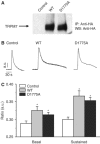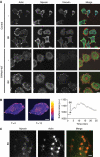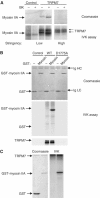TRPM7, a novel regulator of actomyosin contractility and cell adhesion
- PMID: 16407977
- PMCID: PMC1383514
- DOI: 10.1038/sj.emboj.7600931
TRPM7, a novel regulator of actomyosin contractility and cell adhesion
Abstract
Actomyosin contractility regulates various cell biological processes including cytokinesis, adhesion and migration. While in lower eukaryotes, alpha-kinases control actomyosin relaxation, a similar role for mammalian alpha-kinases has yet to be established. Here, we examined whether TRPM7, a cation channel fused to an alpha-kinase, can affect actomyosin function. We demonstrate that activation of TRPM7 by bradykinin leads to a Ca(2+)- and kinase-dependent interaction with the actomyosin cytoskeleton. Moreover, TRPM7 phosphorylates the myosin IIA heavy chain. Accordingly, low overexpression of TRPM7 increases intracellular Ca2+ levels accompanied by cell spreading, adhesion and the formation of focal adhesions. Activation of TRPM7 induces the transformation of these focal adhesions into podosomes by a kinase-dependent mechanism, an effect that can be mimicked by pharmacological inhibition of myosin II. Collectively, our results demonstrate that regulation of cell adhesion by TRPM7 is the combined effect of kinase-dependent and -independent pathways on actomyosin contractility.
Figures









Similar articles
-
TRPM7 triggers Ca2+ sparks and invadosome formation in neuroblastoma cells.Cell Calcium. 2013 Dec;54(6):404-15. doi: 10.1016/j.ceca.2013.09.003. Epub 2013 Oct 16. Cell Calcium. 2013. PMID: 24176224 Free PMC article.
-
TRPM7 regulates myosin IIA filament stability and protein localization by heavy chain phosphorylation.J Mol Biol. 2008 May 9;378(4):790-803. doi: 10.1016/j.jmb.2008.02.057. Epub 2008 Mar 4. J Mol Biol. 2008. PMID: 18394644 Free PMC article.
-
The alpha-kinases TRPM6 and TRPM7, but not eEF-2 kinase, phosphorylate the assembly domain of myosin IIA, IIB and IIC.FEBS Lett. 2008 Sep 3;582(20):2993-7. doi: 10.1016/j.febslet.2008.07.043. Epub 2008 Aug 7. FEBS Lett. 2008. PMID: 18675813
-
The Mg2+ and Mg(2+)-nucleotide-regulated channel-kinase TRPM7.Handb Exp Pharmacol. 2007;(179):313-28. doi: 10.1007/978-3-540-34891-7_19. Handb Exp Pharmacol. 2007. PMID: 17217066 Free PMC article. Review.
-
TRPM7: a unique channel involved in magnesium homeostasis.Int J Biochem Cell Biol. 2012 Aug;44(8):1381-4. doi: 10.1016/j.biocel.2012.05.010. Epub 2012 May 24. Int J Biochem Cell Biol. 2012. PMID: 22634382 Review.
Cited by
-
Elucidating the role of the TRPM7 alpha-kinase: TRPM7 kinase inactivation leads to magnesium deprivation resistance phenotype in mice.Sci Rep. 2014 Dec 23;4:7599. doi: 10.1038/srep07599. Sci Rep. 2014. PMID: 25534891 Free PMC article.
-
Non-coding RNAs as Key Regulators of the Notch Signaling Pathway in Glioblastoma: Diagnostic, Prognostic, and Therapeutic Targets.CNS Neurol Disord Drug Targets. 2024;23(10):1203-1216. doi: 10.2174/0118715273277458231213063147. CNS Neurol Disord Drug Targets. 2024. PMID: 38279763 Review.
-
The immunological synapse: a dynamic platform for local signaling.J Clin Immunol. 2010 May;30(3):364-72. doi: 10.1007/s10875-010-9393-6. J Clin Immunol. 2010. PMID: 20390326 Free PMC article. Review.
-
Transient receptor potential channel TRPM8 is over-expressed and required for cellular proliferation in pancreatic adenocarcinoma.Cancer Lett. 2010 Nov 1;297(1):49-55. doi: 10.1016/j.canlet.2010.04.023. Epub 2010 Jun 1. Cancer Lett. 2010. PMID: 20605675 Free PMC article.
-
Adipose-specific deletion of the cation channel TRPM7 inhibits TAK1 kinase-dependent inflammation and obesity in male mice.Nat Commun. 2023 Jan 30;14(1):491. doi: 10.1038/s41467-023-36154-3. Nat Commun. 2023. PMID: 36717580 Free PMC article.
References
-
- Burgstaller G, Gimona M (2004) Actin cytoskeleton remodelling via local inhibition of contractility at discrete microdomains. J Cell Sci 117: 223–231 - PubMed
-
- Burridge K, Wennerberg K (2004) Rho and Rac take center stage. Cell 116: 167–179 - PubMed
-
- De la Roche MA, Smith JL, Betapudi V, Egelhoff TT, Cote GP (2002) Signaling pathways regulating Dictyostelium myosin II. J Muscle Res Cell Motil 23: 703–718 - PubMed
-
- DeMali KA, Wennerberg K, Burridge K (2003) Integrin signaling to the actin cytoskeleton. Curr Opin Cell Biol 15: 572–582 - PubMed
-
- Dorovkov MV, Ryazanov AG (2004) Phosphorylation of annexin I by TRPM7 channel-kinase. J Biol Chem 279: 50643–50646 - PubMed
Publication types
MeSH terms
Substances
LinkOut - more resources
Full Text Sources
Other Literature Sources
Molecular Biology Databases
Miscellaneous

